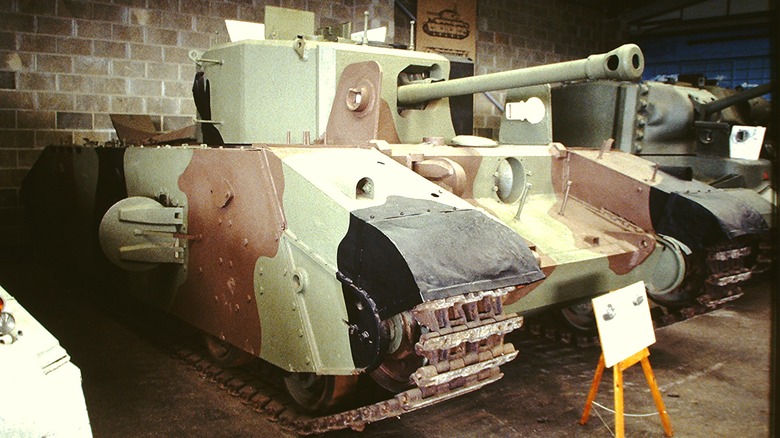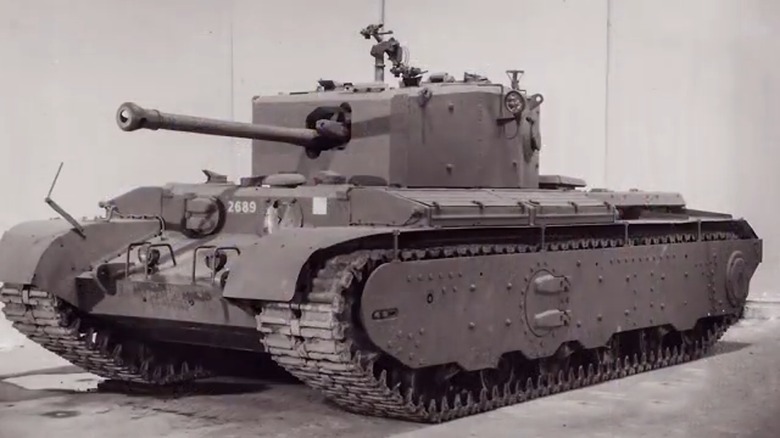Was The Excelsior Tank Any Good, & How Many Were Actually Made?
The Great War introduced tanks to modern warfare, and by WWII, armies worked tirelessly to place superior armored vehicles on the battlefield. Each nation vied for battlefield dominance with numerous tank models, and the United Kingdom was no exception. The U.K. fielded several tanks throughout the conflict, though its most well-known are probably the Mk VI A15 Crusader, the Mk IV A22 Churchill cruiser tank, or the Mk VIII A27M Cromwell infantry tank.
Ideally, the U.K. hoped to field a new tank with a chassis that could be easily modified to work as cruisers or infantry tanks. In this pursuit, English Electric, which built the Cromwell, was tasked with building a new "universal tank chassis" from the Mk VIII A27M, which was designated the A33 Excelsior. Had this design worked and been fully implemented, the U.K. would have fielded a more robust, adaptable armored vehicle.
Unfortunately, the Excelsior did not work out, and while English Electric constructed two prototypes, that's all that was built. Ultimately, the Excelsior wasn't a good replacement for the Churchill or Cromwell, and the U.K. abandoned it. Despite this, it wasn't a terrible tracked vehicle and had it seen combat, it may have proven itself useful as a viable infantry or cruiser tank operating at the European front.
[Featured image by XRobb via Wikimedia Commons | Cropped and scaled | CC BY-SA 3.0]
What worked with the Excelsior?
Unlike many of Germany's largest tanks, the Excelsior weighed 40 tons, placing it on the lower scale of heavy tank designs. This worked well for the British infantry, which used tanks for support during operations throughout Europe. The two prototypes English Electric had several differing features, but for the most part, the tank was equipped with a 75mm main gun and two 7.92 mm BESA machine guns coupled with 35 shells and 5,000 rounds of ammunition, respectively.
Depending on the proposed variations, the tank could also support a 57mm machine gun. The Excelsior required five personnel to operate: a commander, driver, gunner, loader, and radio operator, who also functioned as a machine gunner. The tank boasted 114mm-thick armor covering its vital systems and most of the armored vehicle, while 20mm armor protected other areas on the tank.
The Excelsior was outfitted with a Rolls-Royce "Meteor" 12-cylinder gasoline engine. With its 600-liter capacity and liquid cooling system, the engine propelled the tank up to 24 mph on highways and just under 12 mph on rough terrain. All of these features stacked up relatively well to make the Excelsior an effective tank for World War II combat, but the U.K. government opted not to move forward with the design for several reasons.
[Featured image by Hugh Llewelyn via Wikimedia Commons | Cropped and scaled | CC BY-SA 2.0 DEED]
Why did the Excelsior fail?
Testing of the prototypes did not indicate either model would rise to the challenge of replacing the Cromwell or Churchill tanks. When put through the paces, the Excelsior performed well in driving tests regarding speed but had difficulty navigating rough terrain. What the tank did not do well was meet the expectations of the desired combat range. The Excelsior was limited to around 99.4 miles, which wasn't nearly enough to make it a practical combat vehicle. The Excelsior's range was likely limited by its massive size, contrasting the much lighter Cromwell's 27.6 tons.
Normally, problems like range and maneuverability would be addressed through refinements in the design process, but something happened with the Excelsior's competition that upended its development. The Churchill had several issues that made a new tank desirable, including having a relatively small main gun. While the Excelsior's development was underway, Vauxhall Motors fixed the issues the British Army had with the Churchill, making the Excelsior no longer necessary.
What began as a project to integrate multiple tanks into a single option ultimately resulted in improvements to the tanks the Excelsior was meant to replace. Had the project continued, the Excelsior may have proven itself on the battlefield, but given its abandonment, there's no way to say how it would have performed once the design issues were ironed out. One of the two prototypes still exists and is located at the Bovington Tank Museum, though it's not on display and resides in the museum's Vehicle Conservation Center.


